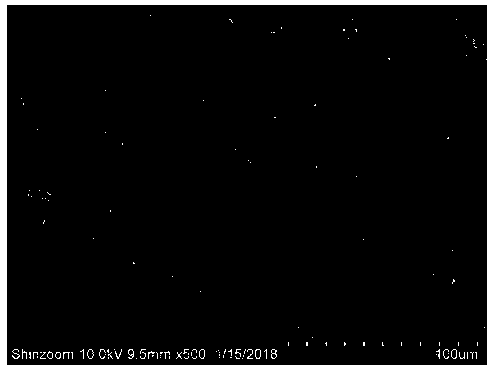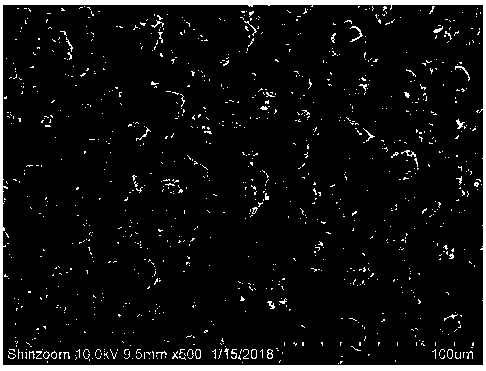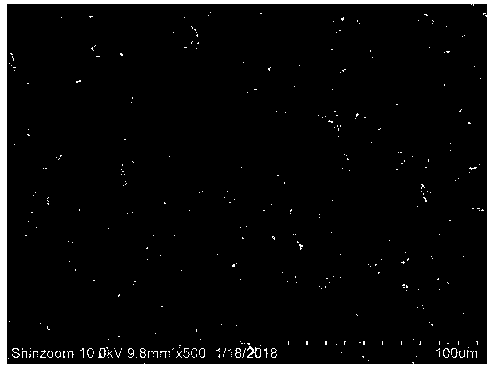Multi-component silicon carbon material and preparation method thereof
A silicon carbon material and multi-component technology, applied in the direction of electrical components, electrochemical generators, battery electrodes, etc., can solve the problems of high cost, unindustrialization of process routes, cumbersome processes, etc., to solve the problems of expansion and circulation, Avoid circular diving and cushion the effect of volume changes
- Summary
- Abstract
- Description
- Claims
- Application Information
AI Technical Summary
Problems solved by technology
Method used
Image
Examples
Embodiment 1
[0036] A method for preparing a multi-component silicon-carbon material for lithium-ion batteries, the preparation steps of which are:
[0037] (I) Evenly disperse nano-silicon, graphene and phenolic resin in ethanol solvent. The mass ratio of the three solids is nano-silicon: graphene: phenolic resin = 5: 1: 12.5, and the mass of ethanol added is silicon: ethanol = 1 : 21, mechanical stirring until the slurry is uniform;
[0038] (II) Under the protection of nitrogen at 130°C, dry the above slurry in a boiling dryer to make powder, and then mold it into a cylinder at 20MPa, with a diameter of 160mm and a height of 120mm;
[0039] (Ⅲ) Heat-treat the block at 550°C under a nitrogen atmosphere, cool it naturally after constant temperature for 2 hours, take it out, crush it, and classify it to obtain a powder with a particle size of 12 μm;
[0040] (Ⅳ) Mix the above powder and asphalt (residual carbon rate 80%) uniformly with a VC mixer at a mass ratio of 88:12, with a mixing sp...
Embodiment 2
[0042] A method for preparing a multi-component silicon-carbon material for lithium-ion batteries, the preparation steps of which are:
[0043] (I) Evenly disperse nano-silicon, carbon nanotubes and asphalt in propanol solvent. The mass ratio of the three solids is nano-silicon: carbon nanotubes: asphalt = 5:0.2:12.5, and the mass of ethanol added is silicon: propanol =5:159, mechanical stirring until the slurry is uniform;
[0044](II) Under the protection of nitrogen at 280°C, dry the above slurry in a flash dryer to make powder, and then mold it into a cylinder at 140MPa, with a diameter of 160mm and a height of 120mm;
[0045] (Ⅲ) Heat-treat the block at 500°C in an argon atmosphere, cool it naturally after constant temperature for 2 hours, take it out, crush it, and classify it to obtain a powder with a particle size of 10 μm;
[0046] (Ⅳ) Mix the above powder and pitch (78% residual carbon rate) with VC according to the mass ratio of 90:10, the mixing speed is 80rpm, th...
Embodiment 3
[0048] A method for preparing a multi-component silicon-carbon material for negative electrodes of lithium-ion batteries, the preparation steps of which are:
[0049] (I) Evenly disperse nano-silicon, carbon black, artificial graphite conductive agent and phenolic resin in isopropanol. The mass ratio of the four solids is nano-silicon: carbon black: artificial graphite conductive agent: phenolic resin=5:0.2: 0.8:12.5, add ethanol mass as silicon:ethanol=5:74, mechanically stir until the slurry is uniform;
[0050] (II) Under the protection of nitrogen at 170°C, dry the above slurry in a spray dryer to make powder, and then isostatically press it under 140MPa to form a cylinder with a diameter of 160mm and a height of 200mm;
[0051] (Ⅲ) Heat-treat the block at 500°C under a nitrogen atmosphere, cool it naturally after constant temperature for 2 hours, take it out, crush it, and classify it to obtain a powder with a particle size of 11 μm;
[0052] (Ⅳ) Mix the above powder wit...
PUM
| Property | Measurement | Unit |
|---|---|---|
| diameter | aaaaa | aaaaa |
Abstract
Description
Claims
Application Information
 Login to View More
Login to View More - R&D
- Intellectual Property
- Life Sciences
- Materials
- Tech Scout
- Unparalleled Data Quality
- Higher Quality Content
- 60% Fewer Hallucinations
Browse by: Latest US Patents, China's latest patents, Technical Efficacy Thesaurus, Application Domain, Technology Topic, Popular Technical Reports.
© 2025 PatSnap. All rights reserved.Legal|Privacy policy|Modern Slavery Act Transparency Statement|Sitemap|About US| Contact US: help@patsnap.com



